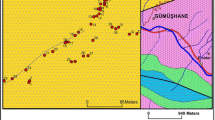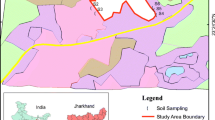Abstract
The present article discusses an overview on the contamination of non-segregated open municipal solid waste (MSW) in and around a dumping site at Garchuk in Guwahati city, Assam, India. Analysis showed depth-wise variations in the concentrations of selected heavy metals in MSW and their subsequent accumulations with increasing depths. Zinc was the most abundant heavy metal in MSW. Six-step selective sequential extractions revealed that most of the heavy metals in MSW were in the residual phase except zinc. Analysis of the leachate from MSW showed high concentrations of fluoride, chloride, ammonium–nitrogen and the ratio of biological oxygen demand/chemical oxygen demand. Concentrations of all the heavy metals in the leachates were higher than the Indian national effluent standards. High amounts of biological oxygen demand, heavy metals, total and fecal coliforms in water samples from the adjoining water body (Deepor Beel, a Ramsar site) of the MSW dumping site indicated its unsuitability for domestic use. Principle component analysis showed that influence of MSW leachate was the major source of water contamination in Deepor Beel. Though accumulation of heavy metals in different vegetables growing in MSW dumping site did not exceed the recommended maximum intake, it was a significant additional source of heavy metals in cooked human diet.





Similar content being viewed by others
References
Adriano DC (1986) Trace elements in the terrestrial environment. Springer, New York
Alonso E, Callejon M, Jimenez JC, Ternero M (2002) Heavy metal extractable forms in sludge from wastewater treatment plants. Chemosphere 47(7):765–775
APHA (American Public Health Association) (1995) Standard methods for the examination of water and wastewater. Washington
Bhattacharyya P, Chakraborty A, Bhattacharya B, Chakrabarti K (2003) Evaluation of municipal solid waste compost as a component of integrated nutrient management in rain fed wetland rice. Compost Sci Util 11:343–350
Bhattacharyya P, Chakraborty A, Chakrabarti K, Tripathy S, Powell MA (2005) Chromium uptake by rice and accumulation in soil amended with municipal solid waste compost. Chemosphere 60(10):1481–1486
Bhattacharyya P, Mitra A, Chakrabarti K, Chattopadhyay DJ, Chakraborty A, Kim K (2008a) Effect of heavy metals on microbial biomass and activities in century old landfill soil. Environ Monit Assess 136(1–3) pp 299–306
Bhattacharyya P, Chakraborty A, Chakrabarti K, Tripathy S, Powell MA (2008b) Fractionation and bioavailability of lead in municipal solid waste compost and uptake by rice straw and grain under submerged condition. Geosci J 12(1):41–45
Biswas AK, Kumar S, Babu SS, Bhattacharyya JK, Chakrabarti T (2010) Studies on environmental quality in and around municipal solid waste dumpsite. Resour Conserv Recycl 55(2):129–134
Bremner JM, Mulvaney RG (1982) Nitrogen total. In: Page AL, Miller RH, Keeney DR (eds) Methods of soil analysis. American Society of Agronomy, Madison, pp 575–624
Bureau of Indian Standard (BIS) 1999 Indian standard specification for drinking water. IS, 10500, New Delhi, India
Chian ESK, DeWalle FB (1976) Sanitary landfill leachates and their treatment. J Environ Eng 4(2):411–431
Doedens H, Cord-Landwehr K (1989) Leachate recirculation. In: Christensen TH, Cossu R, Stegmann R (eds) Sanitary landfilling: process, technology and environmental impact. Academic Press Ltd, London
Ehrig HJ (1983) Quality and quantity of sanitary landfill leachate. Waste Manage Res 83(1):53–68
Ehrig HJ, Scheelhaase T (1993) Pollution potential and long term behavior of sanitary landfills. In: Proceedings of the fourth international landfill symposium. Cagliari, Italy
Epstein E (1997) The science of composting. Technomic Publishing Co. Inc, Lancaster
Flyhammar P, Tamaddon F, Bengtsson L (1998) Heavy metals in a municipal solid waste deposition cell. Waste Manage Res 16(5):403–410
Fuentes A, Llorens M, Saez J, Aguilar MI, Ortuno JF, Meseguer VF (2004) Phytotoxicity and heavy metals speciation of stabilised sewage sludges. J Hazard Mater 108(3):161–169
He P, Shao L, Qu X, Li G, Lee D (2005) Effects of feed solutions on refuse hydrolysis and landfill leachate characteristics. Chemosphere 59(6):837–844
He P, Xiao Z, Shao LM, Yu JY, Lee DJ (2006) In situ distribution and characteristics of heavy metals in full-scale landfill layers. J Hazard Mater 137(3):1385–1394
Helena B, Pardo R, Vega M, Barrado E, Fernandez JM, Fernandez L (2000) Temporal evolution of groundwater composition in an alluvial aquifer (Pisuerga River, Spain) by principal component analysis. Water Res 34(3):807–816
Hogland W, Marques M (2003) Physical, biological and chemical processes during storage and spontaneous combustion of waste fuel. Resour Conserv Recycl 40(1):53–69
ICMR (Indian Council of Medical Research) (2001) Health Guide. New Delhi, India
Iyer CS, Sindhu M, Kulkarni SG, Tambe SS, Kulkarni BD (2003) Statistical analysis of the physico chemical data on the coastal waters of Cochin. J Environ Monit 5(2):324–327
Jackson ML (1995) Soil chemical analysis. Prentice Hall of India, New Delhi
Karak T, Bhagat RM, Bhattacharyya P (2012) Municipal solid waste generation, composition and management: The world scenario. Critical Rev Environ Sci Technol 42(15):1509–1630
Keon NE, Swartz CH, Brabander DJ, Harvey C, Hemond HF (2001) Validation of an arsenic sequential extraction method for evaluating mobility in sediments. Environ Sci Technol 35(13):2778–2784
Kjeldsen P, Barlaz MA, Rooker AP, Baun A, Ledin A, Christensen TH (2002) Present and long term composition of MSW landfill leachate: a review. Crit Rev Environ Sci Technol 32(4):297–336
Kumar S, Gaikwad SA (2004) Municipal solid waste management in Indian urban centres: an approach for betterment, urban development debates in the new millennium. Atlantic Publishers & Distributors, New Delhi
Lax A, Roig A, Costa F (1986) A method for determining the cation-exchange capacity of organic materials. Plant Soil 94(3):349–355
Lo I (1996) Characteristics and treatment of leachates from domestic landfills. Environ Int 22(4):433–442
Mitra A, Bhattacharyya P, Chattopadhyay DJ, Chakraborty A, Chakrabarti K (2003) Physico-chemical properties, heavy metals and their relations in cultivated landfill soils dumped with municipal solid wastes. Arch Agron Soil Sci 49(2):163–170
Municipal Solid Wastes (Management and Handling) Rules (2000) Ministry of environment and forests. Govt of India, New Delhi
Narwal RP, Singh BR (1998) Effect of organic materials on partitioning, extractability and plant uptake of metals in an alum shale soil. Water Air Soil Pollut 103(1–4):405–421
Neill M (2004) Microbiological Indices for total coliform and E. coli bacteria in estuarine waters. Mar Pollut Bull 49(9–10):752–760
Nelson DW, Sommers LE (1982) Total carbon, organic carbon, and organic matter. In: Page AL, Miller RH, Keeney DR (ed) Methods of soil analysis. Part 2 Chemical and microbiological properties, 2nd edn, American Society of Agronomy and Soil Science Society of America, Wisconsin pp 539–79
Ostman M, Wahlberg O, Agren S, Matensson AM (2006) Metal and organic matter contents in a combined household and industrial landfill. Waste Manage (Oxford) 26(1):29–40
Oygard JK, Gjengedal E, Royset O (2007) Size charge fractionation of metals in municipal solid waste landfill leachate. Water Res 41(1):47–54
Ozturk I, Altinbas M, Koyuncu I, Arikan O, Gomec-Yangin C (2003) Advanced physico-chemical treatment experiences on young municipal landfill leachates. Waste Manage (Oxford) 23(5):441–446
Prechthai T, Parkpian P, Visvanathan C (2008) Assessment of heavy metal contamination and its mobilization from municipal solid waste open dumping site. J Hazard Mater 156(1–3):86–94
Reinhart DR, Al-Yousfi AB (1996) The impact of leachate recirculation on municipal solid waste landfill operating characteristic. Waste Manage Res 14(4):337–346
Renou S, Givaudan JG, Poulain S, Dirassouyan F, Moulin P (2008) Landfill leachate treatment: review and opportunity. J Hazard Mater 150(3):468–493
Richman MB (1986) Rotation of principal components. Int J Climatol 6(3):293–335
Robinson AH (2005) Landfill leachate treatment. Membr Technol 6:6–12
Rudel H, Terytze K (1999) Determination of extractable chromium (VI) in soils using a photometric method. Chemosphere 39(4):697–708
Sanchez-Monedero MA, Roig A, Martinez-Pardo C, Cegarra J, Paredes C (1996) A microanalysis method for determining total organic carbon in extracts of humic substances. Relationships between total organic carbon and oxidable carbon. Bioresour Technol 57(3):291–295
Sharholy M, Ahmad K, Mahmood G, Trivedi RC (2008) Municipal solid waste management in Indian cities-A review. Waste Manage (Oxford) 28(2):459–467
Shekdar AV (2009) Sustainable solid waste management: integrated approach for Asian countries. J Waste Manage 29(4):1438–1448
Tchobanoglous G, Theisen H, Vigil SA (1993) Integrated solid waste management. McGraw-Hill Inc, USA
Tessier A, Campbell PGC, Bisson M (1979) Sequential extraction procedure for the speciation of particulate trace metals. Anal Chem 51(7):844–850
Thauer RK (1998) Biochemistry of methanogenesis: a tribute to Marjory Stephenson. Microbiology 144(9):2377–2406
Thomsen M, Lassen P, Dobel SP, Hansen E, Carlsen L, Mogensen BB (2002) Characterisation of humic materials of different origin: a multivariate approach for quantifying the latent properties of dissolved organic matter. Chemosphere 49(10):1327–1337
Tripathi RM, Raghunath R, Krishnamoorthy TM (1997) Dietary intake of heavy metals in Bombay city, India. Sci Total Environ 208(3):149–159
UNICEF (1999) WATER front, fluoride in water: an overview. UNICEF Programme Division, WES Section, USA
US Environmental Protection Agency (2007) SW-846 test methods for evaluating solid wastes, December 26. http://www.epa.gov/sw-846/main.htm
USEPA (United States Environmental Protection Agency) (1999) Standard for the use or disposal of sewage sludge, 40 CFR Part 503 sewage sludge rule. Federal Registe, USA
Weast R, Astle MJ, Beyer WH (1985) CRC handbook of chemistry and physics. CRC Press Inc, Boca Ranton
WHO (World Health Organization) (1993) Evaluation of certain food additives and contaminants, WHO technical report series, number 837. World Health Organization, Geneva
WHO (World Health Organization) (1997) Guideline for drinking water quality health criteria and other supporting information, 2nd edn, Geneva
Xiaoli C, Shimaoka T, Xianyan C, Qiang G, Youcai Z (2007) Characteristics and mobility of heavy metals in an MSW landfill: implication in risk assessment and reclamation. J Hazard Mater 144(1–2):485–491
Ysart GE, Miller PF, Crews H, Robb P, Baxter M, Delargy C, Lofthouse S, Sargent C, Harrison N (1999) Dietary exposure estimates of 30 metals and other elements from the UK total diet study. Food Addit Contam 16(9):391–403
Zucconi F, Pera A, Forte M, de Bertoldi M (1981) Evaluating toxicity of immature compost. Biocycle 22:54–57
Acknowledgments
The authors are grateful to the anonymous reviewers for their insightful comments that have enabled them in improving the quality of the article. The authors gratefully acknowledge Dr. M. Hazarika, Director, Tocklai Experimental Station, Tea Research Association, Jorhat, Assam; Dr. Suhas Ghosh, Former Faculty Member, Chemistry Department, St. Paul’s Cathedral Mission College, Kolkata, West Bengal, India and Dr. Sampa Das, Dibrugarh Polythechnic, Assam, India, for their valuable comments and helpful suggestions during the preparation of this manuscript. The authors are also thankful to Mr. Shyamal Chakravorty and Dr. Sukumar Debnath of Tocklai Experimental Station, Jorhat, Assam, India, for their valuable suggestions to improve the manuscript.
Author information
Authors and Affiliations
Corresponding author
Rights and permissions
About this article
Cite this article
Karak, T., Bhattacharyya, P., Das, T. et al. Non-segregated municipal solid waste in an open dumping ground: a potential contaminant in relation to environmental health. Int. J. Environ. Sci. Technol. 10, 503–518 (2013). https://doi.org/10.1007/s13762-013-0184-5
Received:
Revised:
Accepted:
Published:
Issue Date:
DOI: https://doi.org/10.1007/s13762-013-0184-5




